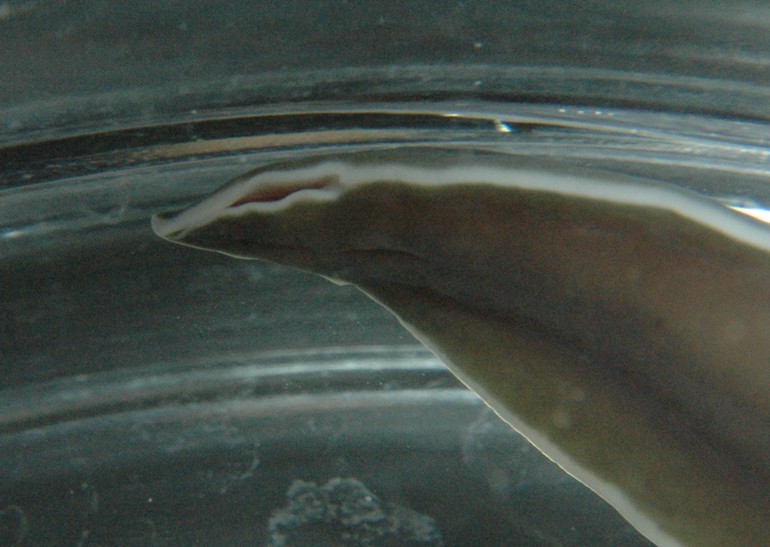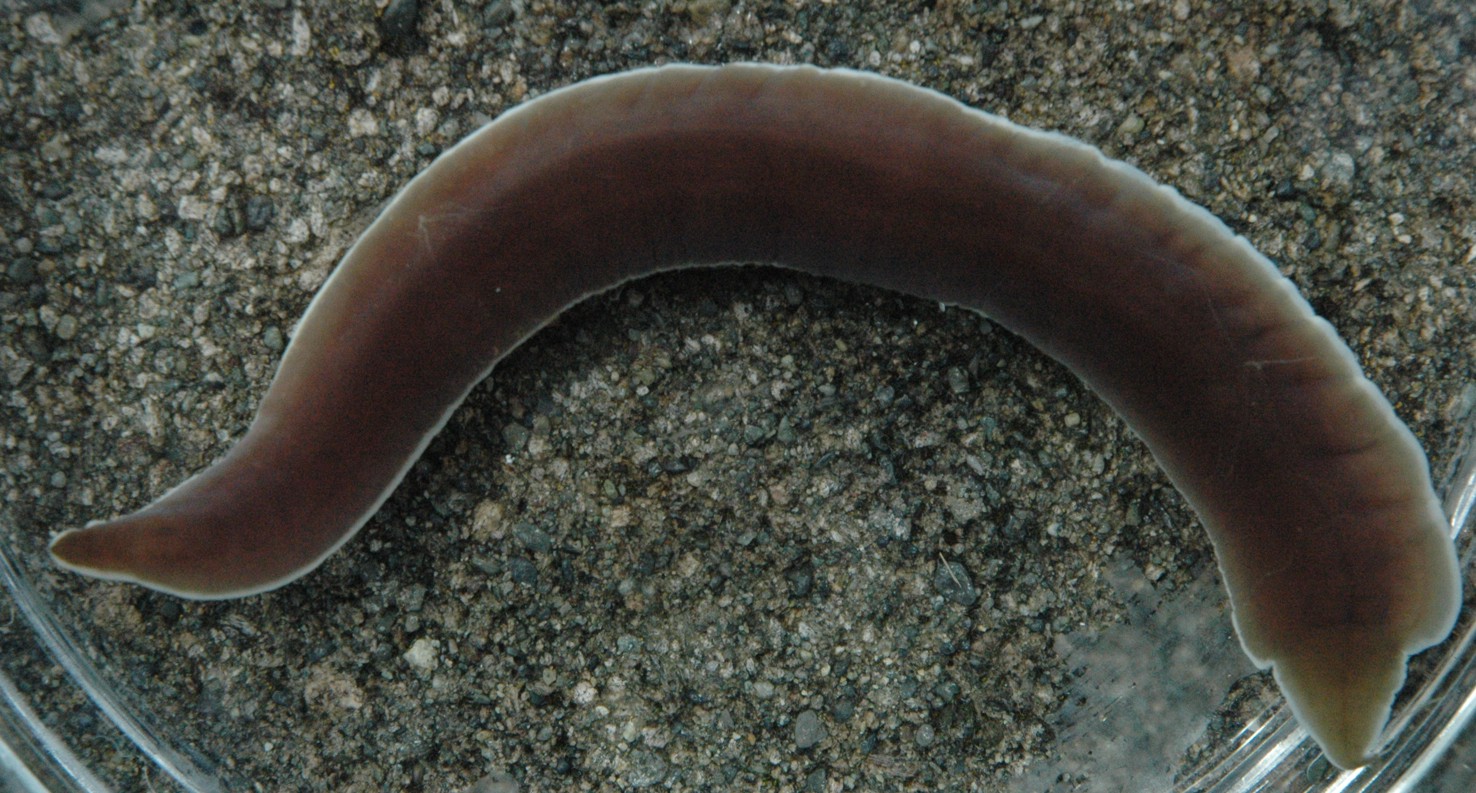Description: This very large, wide nemertean, as with other members of Class Anopla, has separate ventral openings for the mouth and proboscis (photo). The head has lateral cephalic slits as is characteristic of lineiform members of the Order Heteronemertea (photo). Heteronemerteans have no stylets on their proboscis but they do have a pair of cerebral sense organs. GenusCerebratulus is typically long and flattened with thin margins and swims readily in an undulating fashion. They have a caudal cirrus that is easily broken off. Most do not have eyes. They may roll up spirally or may twist but typically do not lengthen or contract much or wad themselves into a tangled 'gordian knot' mass as do some other nemerteans. Their head is pointed anteriorly but can change in shape. They have long and deep cephalic slits. The body usually is of a plain color. This individual has a caudal cirrus (photo). The body is a brownish or olive green both dorsally and ventrally (though not the same shade), with the edges bordered in white. I could find no eyes, yet the individual was at least mildly negatively phototropic (avoided bright lights; although it might have been responding to the infrared heat from the light). It sometimes exhibited a mild side-to-side bending motion as it moved.
This individual does not key satisfactorily in either Kozloff (1996) or Carlton (2007). Therefore I conferred with nemertean specialists Jon Norenburg (Smithsonian Museum of Natural History), Megan Schwartz (University of Washington, Tacoma), and Terra Hiebert (Oregon Institute of Marine Biology). The consensus is that it is a species not often encountered here, best described as Cerabratulus herculeus var latus. Both Cerebratulus herculeus (Coe, 1901) and C. latus (Coe, 1905) were described by Coe from Pacific coast specimens. C. herculeus was described based on an individual collected in Sitka, Alaska by the Harriman Alaska Expedition of 1899. Coe describes the species as having a very large, stout, thick, broad body up to 2 m long (one of the largest nemerteans known!) and a width of more than 2.5 cm; somewhat resembling a leech. Its head was short, thick, and came to a blunt point. It had no ocelli. The proboscis pore was anterior and the large mouth was farther back, at the posterior end of the cephalic slits. The proboscis was large and colorless, and the proboscis (rhyncocoel) sheath ran the entire length of the body. The esophageal region was short and thick; and the intestinal region very broad and flat with thin, wavy margins. The posterior end had a small, pale caudal cirrus at the anal opening. The color was described as very dark brown or reddish brown dorsally, with a rather paler color ventrally. Large numbers were encountered at low tide but only at Sitka. The species was reported to break easily. C. latus was described in 1905 based on a specimen also collected at Sitka by the Harriman Expedition, plus dredged from mud or sand by Stimpson in the Albatross expedition in the Bering Sea, off Cape Flattery, WA, from the Puget Sound, and off central CA. Its body was remarkably short and broad for a Cerebratulus, as well as very wide and strongly flattened, with thin lateral margins. The length was said to vary enormously, with large individuals about 30 cm long and 2.5 cm wide when moderately extended. The head was continuous with the body and there was no demarcation between the esophageal and intestinal region, with the thin lateral margins extending forward to the posterior end of the cephalic slits. The head was broad, with the mouth ventrally beneath the posterior ends of the cephalic slits. The cephalic slits were very short (4 mm). The esophageal region was short and quite flattened, with thin lateral margins continuous with the intestinal region. The intestinal region was very flat, with well-developed dorso-ventral muscles but poorly developed longitudinal muscles. Width up to 2.7 cm and thickness up to 7 cm. It was sometimes concave on the ventral surface. The body tapered gradually posteriorly. The lateral margins were even thinner posteriorly, forming lateral fins. Notably well adapted for swimming, yet thought to live in burrows. The proboscis was very large. Color in life was brownish overall, with a pale brown ventral surface and lateral margins. Definitely paler than C. herculeus. C. herculeus and C. latus were synonymized by Coe (1940) to C. herculeus without comment about the reasons, except in the introduction to the paper in which he states that he synonymized several species based on "intergrading species, younger stages, and color variations" (Coe, 1940 p 247).
How to Distinguish from Similar Species:Cerebratulus marginatus has white margins and is similar in color, but Coe (1905) says it is longer and not nearly as broad and is rounded in the anterior portion. It appears to be found in the Atlantic, Mediterranean, and Pacific. Cerebratulus californiensis may be greenish brown and fragile but has a distinct, narrower neck behind the head.
Geographical Range: From the Bering Sea, Alaska to southern California (where it is subtidal and off-shore).
Depth Range: Intertidal and subtidal
Habitat: Burrowing in mud
Biology/Natural History:Cerabratulus species are active burrowers, but can flatten out and swim as well when outside the sediment. This species is said to fragment easily. When found, this individual was resting on the surface of silty sediment at about 12 m depth, curled up tightly. It is possible that it curled up when the night-time darkness was interrupted by the bright dive lights. On disturbance it straightened out and began to move along the surface of the sediment, undulating from side to side like a snake but more slowly. We did not ever observe it make any substantial change in length.
Nemerteans have a larva called a pilidium larva, which looks a
bit like
an old-fashioned football helmet. According to Lacalli
(2005), Cerebratulus
pilidium larvae are some of the largest of any nemertean, being up to
1.45
mm tall.
| Return to: | |||
| Main Page | Alphabetic Index | Systematic Index | Glossary |
References:
Dichotomous Keys:General References:
Scientific Articles:
Coe, W.R., 1901. Papers of the Harriman Alaska Expedition: 20. The Nemerteans of the Expedition. Proceedings of the Washington Academy of Sciences 3: pp 1-110 and 13 plates.
Coe, W.R., 1905. Nemerteans of the west and northwest coasts of America. Bulletin of the Museum of Comparative Zoology at Harvard College, in Cambridge, Vol. XLVII. 318 pp and 25 plates.
Coe, W.R., 1940. Revision of the nemertean fauna of the Pacific coasts of North, Central, and northern South America. Allan Hancock Pacific Expeditions 2: pp 247-323
Lacalli, Thurston C., 2005. Diversity of form and behaviour among nemertean pilidium larvae. Acta Zoologica 86:4 pp 267-276
Web sites:
General Notes and Observations: Locations, abundances, unusual behaviors:

This ventral
view of
the head shows the proboscis
pore at the anterior
end
(left), and the slit for the large ventral
mouth posterior
to it,
just behind the widening of the body

This side view of the head shows the large cephalic
slit.

This closeup dorsal
view of the head shows the white border but lack of ocelli
(eyespots)

The posterior end has a thin caudal
cirrus which is attached near the anus.
This individual, which may be of the same species, was encountered by Brian Watkins on a soft bottom but then swimming up in Rosario Bay during the day at about 6 m depth on June 26, 2024. Brian estimates the langth at 30 cm. Movie by Brian Watkins.
Authors and Editors of
Page:
Dave Cowles (2014): Created original page
CSS coding for page developed by Jonathan Cowles (2007)
Salish Sea Invertebrates web site provided courtesy of Walla
Walla University
